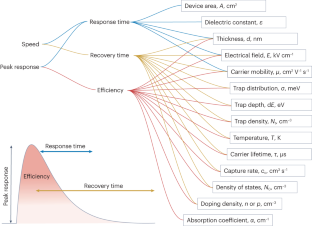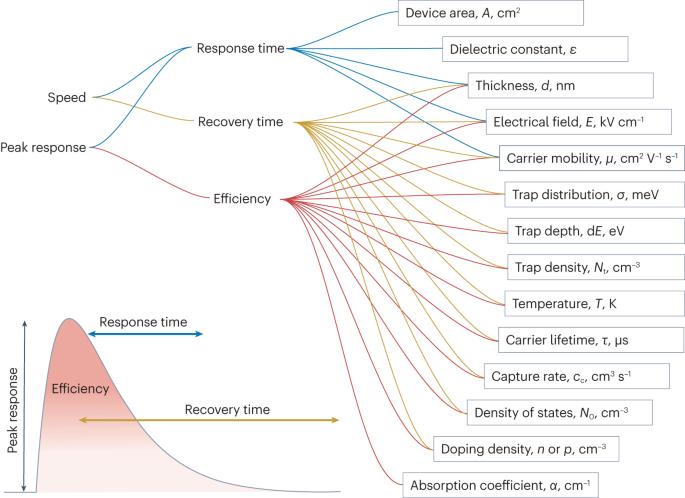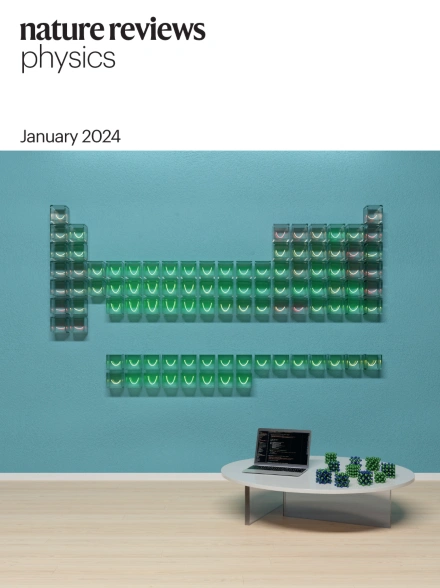高速光电探测材料的光物理特性
IF 44.8
1区 物理与天体物理
Q1 PHYSICS, APPLIED
引用次数: 0
摘要
跨电磁频谱的快速响应光学传感是量子系统、三维机器视觉和增强现实技术的推动力,但现有技术并未针对红外传感进行优化。在速度、效率、噪声、光谱检测范围和成本等特性之间权衡取舍,促使研究界开发出可在可见光到红外波段无缝集成的纳米结构传感材料。在努力提高器件的综合增益和带宽的同时,清楚地了解电荷载流子动力学的物理机制,特别是速度限制过程,是当务之急。在本综述中,我们介绍了活性材料的光物理属性及其对光学传感器性能的影响,重点是对不同持续时间的脉冲光的时间响应和峰值响应之间的相互作用。我们指出了限制性能的过程,以及在开发实现高速光电探测的材料和器件结构方面的未来发展方向。本文章由计算机程序翻译,如有差异,请以英文原文为准。


Photophysical properties of materials for high-speed photodetection
Fast-response optical sensing across the electromagnetic spectrum is an enabler of quantum systems, 3D machine vision and augmented reality, yet existing technologies are not optimized for infrared sensing. Trade-offs among characteristics such as speed, efficiency, noise, spectral detection range and cost motivate the research community to develop nanostructured sensing materials that provide operation from visible to infrared wavelengths with seamless integration. As efforts are made to advance the combined gain and bandwidth of devices, a clear understanding of physical mechanisms underlying the dynamics of charge carriers, with a particular focus on speed-limiting processes, is of high priority. In this Review, we provide an account of the photophysical attributes of active materials and their impact on optical sensor performance, focusing on the interplay between temporal and peak response to pulsed light of varying durations. We identify performance-limiting processes and directions for future progress in developing materials and device architectures that realize high-speed photodetection. Developing photodetectors that work across the electromagnetic spectrum remains a challenge, and there are many trade-offs to be considered, including speed, efficiency, noise, spectral detection range and cost. This Review discusses the photophysical attributes of the active materials that define the interrelated aspects of response amplitude and temporal dynamics in photodetectors.
求助全文
通过发布文献求助,成功后即可免费获取论文全文。
去求助
来源期刊

Nature Reviews Physics
Multiple-
CiteScore
47.80
自引率
0.50%
发文量
122
期刊介绍:
Nature Reviews Physics is an online-only reviews journal, part of the Nature Reviews portfolio of journals. It publishes high-quality technical reference, review, and commentary articles in all areas of fundamental and applied physics. The journal offers a range of content types, including Reviews, Perspectives, Roadmaps, Technical Reviews, Expert Recommendations, Comments, Editorials, Research Highlights, Features, and News & Views, which cover significant advances in the field and topical issues. Nature Reviews Physics is published monthly from January 2019 and does not have external, academic editors. Instead, all editorial decisions are made by a dedicated team of full-time professional editors.
 求助内容:
求助内容: 应助结果提醒方式:
应助结果提醒方式:


